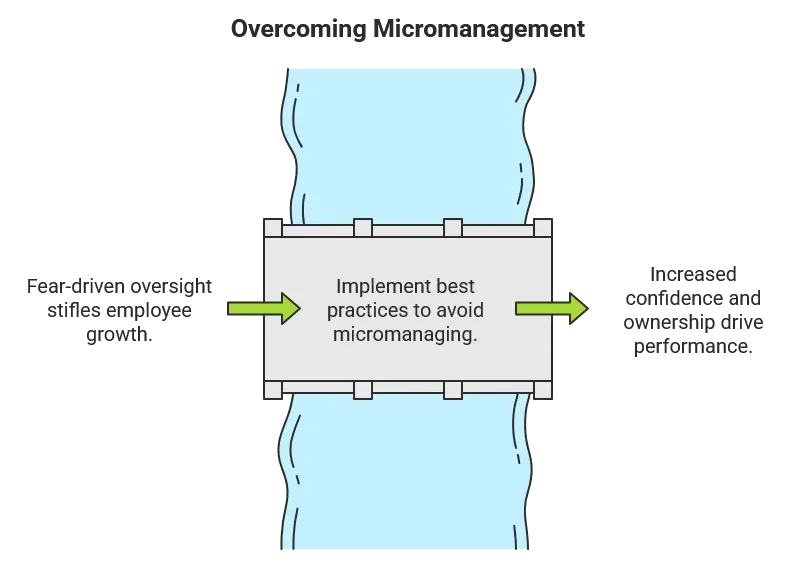Don’t have the time to read?Listen here instead or save to your Spotify playlist. |
Micromanaging is a sign of a lack of trust. And nothing kills a remote team faster than a boss who can’t let go. The truth is, you don’t have to be breathing down someone’s neck to suffocate their productivity. So, how can you stop micromanaging your remote team?
Constant check-ins, over-detailed instructions, and approval bottlenecks all send the same message: you don’t believe your employees can deliver without you.
“Remote work makes the temptation worse. 85% of business leaders have said that the change to hybrid work raises questions about whether employees are really being productive. “You can’t see your employees in action, so you overcompensate by hovering digitally instead. The result? Slower projects, frustrated employees, and a culture that pushes your best people to look elsewhere,” said Ruffy Galang, CEO and Co-Founder of Remote Employee.
The good news? You can fix it. By recognizing when you’ve crossed the line from guiding to controlling, you can reset how you lead, build real trust, and finally let your employees do the work you hired them to do.
In this blog post, we’ll go over the signs you’re micromanaging your employees and how to stop being a micromanager.
Signs You’re Micromanaging Your Employees
You might think you’re just being “thorough,” but there’s a fine line between leading and micromanaging remote workers. If any of these sound like you, it’s time to take a hard look at your management style.
1. You’re Glued to Progress Updates
If your Slack or inbox is full of “just checking in” messages, you’re not leading; you’re smothering. Constant status checks show you don’t trust your employees to move work forward without your eyes on them.
Remote employees already know what’s expected of them. Hovering over every step kills their focus and sends a clear message: you don’t think they’re capable of handling it without you.
2. You Hand Out Instructions Like a Manual
There’s a difference between clear direction and scripting every single move. When you spell out every micro-step, you leave no space for your employees to think, create, or own the work.
Over-detailed task management turns you into the bottleneck and strips your team of the confidence to problem-solve on their own. If you’ve ever been frustrated by employees who “don’t think for themselves,” ask yourself if you’ve left them any room to do so.
3. You Can’t Let Go of Tasks
If your instinct is to keep “small things” on your desk instead of passing them off, you’re clogging the pipeline. Holding everything close only slows down your team and signals you don’t believe they can deliver.
When you hold onto everything, you don’t just waste your own time; you waste your employees’ potential.
4. Your Feedback Feels Like a Magnifying Glass
Pointing out every tiny flaw, every time, makes you exhausting. Instead of motivating, nitpicking chips away at confidence and creates employees who second-guess every move. There’s a difference between coaching and critiquing. Coaching pushes people forward.
Constant nitpicking drags them down. If your team dreads your feedback, it’s a sign you’ve crossed the line.
| How to hire more effective team members: |
How to Stop Micromanaging
Micromanaging doesn’t disappear overnight. It takes intentional changes in how you lead. The good news? Every step you take toward trust, clarity, and support pays off in stronger performance and less stress on you.
1. Start by Hiring the Right People
Micromanaging often comes from fear: Fear that employees won’t deliver without your constant oversight.
One key way how not to micromanage employees? Remote Employee® removes that fear from the start. You don’t get stuck with random placements; you personally interview and choose who you want on your team, just like you would with an onshore hire.
From day one, you know exactly who you’re working with, their qualifications, and how they’ll fit into your business.
With Remote Employee®, you get:
- Direct one-on-one interviews with candidates
- Fortune 500-level talent without the high costs
- Employees working in Class A offices in the Philippines
- Up to 70% savings on labor costs
2. Practice Real Delegation
If you’re assigning work but still holding onto every detail, you’re not delegating; you’re babysitting. The fix? Match projects to each employee’s strengths and then step back. Your job is to set the destination.
Give them the authority and resources they need, and let them take ownership of the result. Leaders who actually delegate give employees the confidence to deliver and the freedom to do their best work.
3. Set Crystal-Clear Expectations
Unclear goals are fuel for micromanagement. If your team doesn’t know exactly what success looks like, you’ll end up chasing them for updates and course-correcting every move.
Spell out what needs to be achieved, when it’s due, and how success will be measured. Then get out of the way. Clarity upfront eliminates the urge to hover later, because everyone already knows the target they’re aiming for.

4. Redefine Your Role
Your job is to lead. Micromanagers blur the line between leadership and control, and that’s why they stay stuck in the weeds. Getting bogged down in the details is also how to not micromanage employees.
Reframe your role as the leader who:
- Clears roadblocks before they stall progress
- Focuses on the big picture instead of every detail
- Provides support and guidance
- Builds employees who can perform without you breathing down their neck
When you shift from micromanager to enabler, your employees perform better and you finally free yourself to focus on growth.
5. Stop Being the Bottleneck
If deadlines keep slipping, you’re probably the reason why. When every task needs your stamp of approval, projects stall, morale tanks, and clients notice. You built a team for a reason. Let them actually carry the weight.
Here’s how to step back:
- Assign roles with clear accountability.
- Hand off deliverables without demanding to review every step.
- Trust that employees can finish strong without you micromanaging the clock.
6. Invest in Their Growth
Another key way how to not micromanage? If you don’t trust your employees to meet your standards, ask yourself: Have you given them the tools to get there? Micromanaging thrives when leaders don’t invest in their people. If you want a team that delivers without constant oversight, you need to back their development.
Smart leaders fund training and certifications. Share resources that build skills. Encourage ongoing learning instead of hoarding knowledge. Plus, companies that invest in structured training see 218% higher income per employee, and up to 21% higher profitability.
When you invest in their growth, you build employees who are confident, capable, and less reliant on you for every answer. That’s how you move from manager to leader.
Stop Asking How to Avoid Micromanaging. Hire the People You Can Trust.
Stop wasting energy hovering over tasks your employees should own. With Remote Employee®, you can hire skilled offshore professionals who know how to deliver from day one.
✅ Interview and choose your hires directly
✅ Slash labor costs by up to 70%
✅ Work with Fortune 500-level talent in Class A offices
✅ Keep full control while we handle payroll, compliance, and setup
If you’re ready to stop micromanaging and start leading, book your free consultation with Remote Employee® today.sourcing top-tier talent to helping you implement these strategies effectively, we’re your partner in remote excellence.









